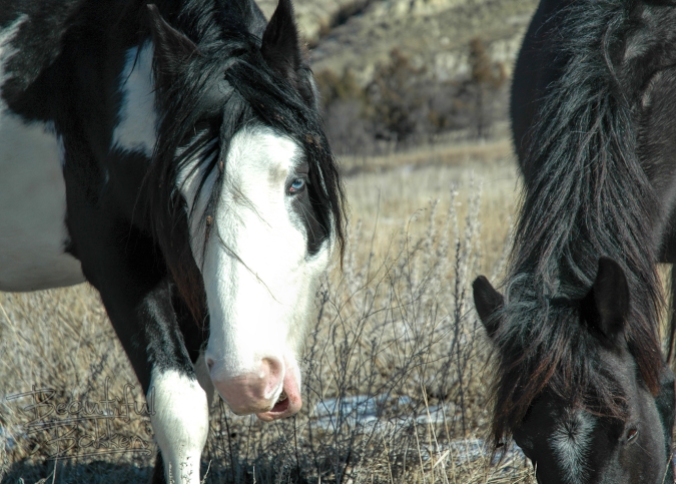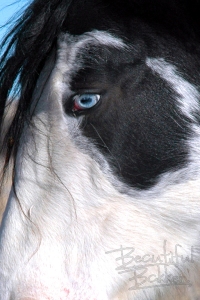Are the wild horses a special breed?
Sitting Bull’s sacred horse descendants – are they at the Theodore Roosevelt National Park? There are some who think there is a good reason to believe they are.

A pair of the wild horses in the South Unit of the Theodore Roosevelt National Park graze nearby me
How to meet the Park residents

This one kept getting closer and I kept getting more nervous, so I backed up the hill behind me to watch it wander down the trail
Many/some/a few years back, I hiked the South Unit of the Theodore Roosevelt National Park two or three times a week. Those were good healing at a time when I needed them. Eventually, it led to close encounters with the residents of the Park: elk, bison and the wild horses.
Over the course of that year, I learned where to sit and how to remain patient enough to become part of the environment. At that time, I had a herd of elk run past me, about 10 to 12 feet away. I also had bison graze their way up to near where I sat — 25 feet or so. They’re too frightening and dangerous to get even that close. I don’t do that anymore.

One of a herd of bison continued to graze toward me as I sat cautiously. He got about 15 feet from me until I chickened out.
Sitting Bull’s spiritual horses
That’s when one of my favorite moments of quietness happened. It was with the wild horses of the South Unit. I was not only alone but also lonely. They may have sensed my condition as they grazed up to me.

Circus often can be spotted on the west end of the park, sometimes on the west side of the Little Missouri River.
This one caught my eye and over time that afternoon, I got close enough to get startling photos of what I later learned was a sacred Medicine Hat horse.
There is no single definition of what exactly marks a Medicine Hat horse, and I do not claim to provide the definitive answer. So, I read what I could find — and not everything came to the same conclusion.
I found out equine enthusiasts and historians differ on the lineage of the horses in the Theodore Roosevelt National Park. However, they seem to agree that a War Bonnet Horse or Medicine Hat horse has distinctive facial or head coloring, usually a “cap” or bonnet that is different from the face. Some say that the sides of the horse’s face are opposite colors. And then others say that the eyes have to be “painted” or “circled.” Still, others say at least one eye must be blue, a “heaven eye.”

The blue eye or “heaven eye” on one side, and brown on the other sets this medicine hat horse apart from the others.
The Debate over the wild horses
The wild horse herd in the South Unit of the TRNP has been the meeting place of years of emotional arguments. Many on one side of the argument say that the core of the herd has a historical lineage that goes back to the Marquis de Mores to Sitting Bull.

A blue eye was considered a heaven eye. The other eye on this horse is brown.
Historical documents show that Sitting Bull’s ponies were taken from him and moved around the territory in a series of transactions, beginning with the taking or surrender of about 350 of his people’s horses at Fort Buford.

Some say that the black cap and ears make this a “war bonnet” paint horse and the blue eye gives it special spiritual significance as having a “heaven eye”
The National Park Service does not recognize the research or claims to the historicity of the horses at the South Unit of TRNP.
Tied to Sitting Bull
One of the most outspoken proponents of the idea the wild horses are from Sitting Bull is an authority on the Sioux Chief. Historian and biographer Robert Utley is known as a top biographer of Sitting Bull and is the former chief historian for the park service. He said historic evidence amassed by Castle McLaughlin, a Harvard anthropologist hired years ago to study the horses at the park, is convincing.
Castle McLaughlin, at Harvard University’s Peabody Museum of Archeology and Ethnology, has linked some of the park’s horses as descendants of ponies surrendered by Sitting Bull and his supporters at Fort Buford in 1881.
Click here to read the transcript of an interview with McLaughlin
Nokota?
In 1993, the North Dakota Legislature designated the Nokota horse as the official state equine, declaring: “The Nokota breed may well be those distinct horses descended from Sioux Chief Sitting Bull’s war ponies.”
So, the issue will likely never be settled to everyone’s agreement. That does not take away the romantic and inspiring impression created by the horses at the South Unit. Most people will be content to spot the horses from the car as they drive through their park.

Two wild horses playfully run past us on a warm summer afternoon at the Theodore Roosevelt National park.
But if you want to get to know them, I recommend frequent visits to learn their favorite neighborhoods and spend time nearby. They are smart critters. They will know you are there. That’s why you probably will not sneak up on them. If you have the right spirit about you, they will know that about you, and so will you.
More Information about the wild horses of the Park
Here are links to learn more about the Nokota and Medicine Hat horses:
https://medium.com/@ryantbell/sitting-bulls-lost-horses-e2c9036d8284#.t623dy7iw
THE SPIRIT OR MEDICINE HORSE By Nanci Falley of Lockart, Texas[reproduced from Spring 2003 issue of Caution:Horses]
Patrick Springer’s excellent overview of the history as of 2007
Want more stories like this? Be sure to subscribe! Wait til you see what’s coming next week:
Got strong legs? Chimney Butte may be the challenge you’ve been looking for. The reward is an awesome view.
The Beautiful Badlands ND Facebook page is a clearinghouse from many sources of news and happenings in the Badlands of North Dakota. So, be sure to follow.



